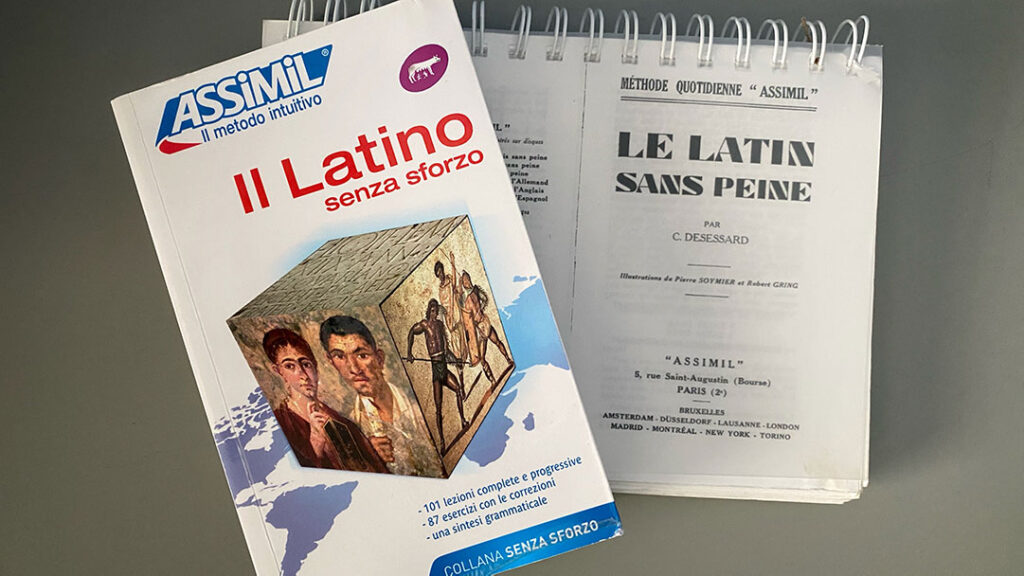Contents
- Latin reading plan, step 1: Familia Romana
- Latin reading plan, step 2: Fabulae Syrae
- Latin reading plan, step 3: Pugio Bruti
- Latin reading plan, step 4: Epitome Historiae Sacrae
- Latin reading plan, step 5: Assimil
- Latin reading plan: Pause and evaluate yourself
- Latin reading plan, step 6: Fabulae Faciles
- Latin Reading Plan, Step 7: Latin Dialogues
- Final suggestions
When you’ve decided to learn Latin, you’re motivated and full of goals and ambitions, then it is time to sit down and plan your studies. Having learnt Latin myself and taught others how to learn it. I’ve put together a reading plan in eight (and a half) step for you to follow or be inspired by.
A good reading plan is one of the most powerful tools for learning Latin, or any language. With a reading plan you will know what to do and when to do it. This will save you time in your strive for learning – if you stick to the plan that is.
If you want to do a reading plan of your own – do it! I suggest you skim through my reading plan below to get some ideas, and then check out Best books for learning Latin, where I’ve gathered my recommendations concerning textbooks, Latin readers, dictionaries, and Latin prose composition course books. Remember, there are countless books out there; these are the ones I would use and have my students read. They are also all readily available.
Without further ado, this is what you could read and study if you want to learn Latin well, in the following order:
Latin reading plan, step 1: Familia Romana
Step one of this reading plan is also the most important one. This is where you lay the foundations for all the rest. Do this step thoroughly and it will make the rest of your studies so much easier, smoother and more efficient.
Step one in the Latin reading plan is to read and study the textbook called Familia Romana by Hans Ørberg. It is the first part of his series Lingua Latina Per Se Illustrata. It is written entirely in Latin and begins with the phrase “Roma in Italia est” and then, with the help of marginal notes and images to explain new words, takes you to more intermediate texts.

To the textbook, Familia Romana belongs an exercise book, Exercitia Latina I, and a dialogue book Colloquia Personarum. And at the beginning of your studies, the textbook and the exercise book are enough, though I recommend using the dialogue book too. A good dictionary is always handy should you double-check something, but it isn’t necessary with Familia Romana.
Make sure you study these books diligently. No skimming or skipping because “I think I know this” or “I recognize this” or “Nah, this is boring” or “I think I’ve got this.” You should be certain you got it. You should know the text almost by heart. Make sure to do the exercises several times. There is also an audio recording of Familia Romana if you can make sure to use that. Read along with the text. Over and over again. Ask yourself questions.
Make sure you master each chapter before moving on to the next—this builds confidence and a strong foundation.
Suggested reading: Step-by-step study routine for learning Latin with Familia Romana
Once you’ve mastered the first half of this book – no sooner – you can move on to step two in the reading plan and get treated to some good stories.
Latin reading plan, step 2: Fabulae Syrae
Once you’ve mastered the first part of Familia Romana, it is time to start reading Fabulae Syrae.
Fabulae Syrae belongs to the Lingua Latina Per Se Illustrata/Familia Romana series. The book has one of the characters from Familia Romana, a slave called Syra, tell stories from the classical world. Each of the stories Syra tells corresponds to a chapter in the second half of Familia Romana.
For every chapter in Familia Romana, you master from now on, read the corresponding story in Fabulae Syrae. This will help you with your vocabulary and syntax and teach you about myths and stories from the Roman world.
Latin reading plan, step 3: Pugio Bruti
When you’re starting to see the end of Familia Romana or have finished it, it is time to read and listen to something fun: Pugio Bruti – A Crime Story in Easy Latin. (I’m a bit biased here as I co-authored it. :))
Pugio Bruti is not a Latin textbook, but a novella, a crime story, written with a vocabulary of 350 words. The Latin is fairly easy, but respects attested classical usage and will put your skills from studying Familia Romana to the test. The book comes with a full Latin-English vocabulary and there are extra resources, such as a list of idioms, free online.

Read the book and make a note of what you don’t quite understand. Then read it again and again. Just like you did with Familia Romana. If you have the possibility, there is also an online course available with exercises and videos in Latin.
Don’t forget to enjoy yourself! Pugio Bruti is written as a book to be both studied and enjoyed. Remember the latter.
Latin reading plan, step 4: Epitome Historiae Sacrae
Step four in my reading plan is turning your attention to the book called Epitome Historiae Sacrae: Brevi Christi Vitae Narratione Addita by Charles Lhomond and Roberto Carfagni.
Epitome Historiae Sacrae is a 17th-century Latin reader with stories from the Bible. It has a rather large vocabulary, but it won’t feel as large as it actually is due to the familiarity of the stories.
Read the book, study it and master it.
Latin reading plan, step 5: Assimil
When you begin with this reading plan’s step 5, you’ve been treated to some good stories for a few steps. It is now time to return to a textbook. This time, Assimil Le Latin sans peine or Assimil Il Latino senza sforzo.
Assimil is a beginner textbook, just like Familia Romana, meaning you will start from the beginning again. However, Assimil is constructed in a very different way than Familia Romana and uses 101 dialogues in Latin to teach you the language.

To get the most out of Assimil, you need to listen to the recordings available of the all the dialogues over and over again to start to develop an intuitive understanding of Latin.
Assimil will help you discover gaps in your knowledge of Latin so far and help you discover many fun passages from Latin literature as many of the dialogues are taken from Latin literature (while other dialogues are just conversations in everyday situations).
Assimil comes with a parallel translation in French or Italian. Don’t let this scare you. If you’ve studied Familia Romana, and possess a decent Latin dictionary, you can cover the translation up and forget it is even there.
Latin reading plan: Pause and evaluate yourself
You have now come a long way, and your foundation in the Latin language should be fairly robust. However, before you celebrate, it is time for some self-examination.
Do you really master the texts in step1‑5? Have you read each book diligently? Or did you perhaps only read Fabulae Faciles once? Did you skip a part? How about grammar and syntax? Did you understand everything in the exercise book? Did you understand every sentence in Pugio Bruti? What do you need to practice?
Be brutally honest with yourself. And remember: It’s not a race. I would like you to master the content of most, or preferably, all of these books and build a strong foundation.
So before you move forward: identify your weak spots and deal with them. Revisit texts or passages if you need to.
Latin reading plan, step 6: Fabulae Faciles
You’ve come a long way! You’ve mastered Familia Romana, worked through exercises, read stories, dialogues, pieces of literature, a crime story in Latin. Before you move forward: pat yourself on the back for a job well done!
Step six in this Latin reading plan is reading Ritchie’s Fabulae Faciles. This book is a classic Latin reader from the 19th century. Like Fabulae Syrae, it contains stories from the vast sea of classical myths, with stories about Ulysses, Hercules, and Perseus.
It is written with frequent use of phrases from Caesar as it was written as a preparation to read Caesar’s De Bello Gallico, which has traditionally been the first Roman text students read in school.
Just like before, study this book diligently. Make sure you master the text. Re-read, then re-read again.
Latin Reading Plan, Step 7: Latin Dialogues

Thus far you have read stories and history largely focused on the third person narrative. Now it is time to widen your vocabulary and accustom yourself to other persons and tenses. It’s time to read more dialogues, this time from the 16th century.
The 16th century was the golden age of the Latin dialogue book with dozens of authors writing dialogues for students to learn to speak Latin. Of these, I suggest you first read Sebald Heyden’s Formulae Colloquiorum. His dialogues will be easy for you now, but still fun. Next, I would suggest you continue with more comprehensive and repetitive dialogues, such as Maturinus Corderius’ Colloquia Scholastica.
Final suggestions
The plan is constructed to give you a great deal of variety but more importantly repetition. It is tempting to skip ahead, read just once, but I have seen so many students pay the price later on. Follow this plan, go through each book meticulously, mastering each step along the way.
Once you’ve done gone through most of this plan you are no longer – by any means – a beginner. Congratulations!
For more information about the books, as well as further book recommendations see Best Books for Learning Latin.
*This article contains affiliate links, which means that we make a small commission from any sales—without affecting the price for you.
















